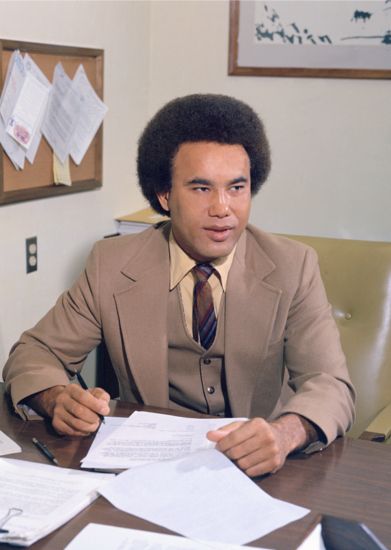Mission Support: Black Scientists Power the Space Program
Through research, innovation, and leadership, African American engineers and scientists have worked to make space exploration a reality.
In 1983, Guy Bluford became the first African American in space as part of the Challenger space shuttle crew. Since then, 15 other Black Americans have flown on NASA flights. To support these manned missions, African American scientists and engineers have worked for decades to make space flight a reality.
In recognition of Black History Month, here are some notable NASA scientists whose contributions ranged from groundbreaking discoveries to critical astronaut support.
Guy Bluford on the Challenger in 1983. Image used courtesy of NASA
America’s First Black Astronaut
While Bluford was the first to go into space, he wasn’t NASA’s first African American astronaut. That honor goes to a decorated Air Force pilot, Robert Henry Lawrence, Jr. (1935-1967). In 1967, he was selected to join NASA’s Manned Orbital Laboratory but never got the chance to fly. Tragically, he died in a plane crash just a few months later.
Robert H. Lawrence, Jr. Image used courtesy of NASA
Still, his contributions to space flight live on. Lawrence earned a Ph.D. in physical chemistry and studied the gliding behavior of spaceships returning to Earth. His research helped develop the space shuttle.
Engineering the Moon Landing
Morgan M. Watson (b. 1943) was an outstanding engineering student in 1964 when he was selected for a NASA-sponsored program at Marshall Space Flight Center in Huntsville, Alabama. Watson worked on testing rocket propulsion and designing ground-support equipment for the Apollo program. Later, he worked at NASA’s Michoud Assembly Facility in New Orleans, where he researched the thermodynamics of the Saturn V rocket. The Saturn V was used in Apollo 11’s moon landing mission.
Morgan Watson. Image used courtesy of Southern University
Watson is now an engineering professor at his alma mater, Southern University in Baton Rouge, Louisiana.
Creating a Moon-Based Telescope
While working for NASA, George R. Carruthers (1939-2020), a gold-plated telescope with an ultraviolet camera and spectrograph. When the Apollo 16 crew walked on the moon in 1972, they installed the telescope in the Descartes highland region and aimed it at Earth. The result was the first-ever photos of the Earth’s geocorona, the outer atmosphere layer that emits ultraviolet light.
George R. Carruthers (right) with the ultraviolet camera/spectrograph. Image used courtesy of NASA
Carruthers was active in educating and mentoring young engineers. President Barack Obama awarded him the National Medal of Technology and Innovation in 2013. Recently, NASA honored Carruthers by naming a 2025 mission for him. The Carruthers Geocorona Observatory will use light from the Earth’s geocorona to observe Earth from space.
Opening Doors at Cape Canaveral
In 1956, Julius Montgomery (1930-2020) became the first African American technician hired to work at the Cape Canaveral space facility. Montgomery worked with a crew known as the Range Rats in the RCA Development Lab. The technicians would repair ballistic missiles and satellite equipment on ships.
Later, Montgomery did electronics work for the Air Force and the shuttle program at NASA.
Technology Protecting Astronauts
In 1962, Samuel J. Scott (1938-2021) was among the first Black engineers to work at NASA’s Langley Research Center in Virginia. Scott helped develop the heat shield to protect spacecraft re-entering the Earth’s atmosphere after space flight.
Samuel Scott at NASA in 1974. Image used courtesy of NASA
Scott worked in the same building as Katherine Johnson, Dorothy Vaughan, and Mary Jackson.
Making History Today
Yvonne Darlene Cagle (b. 1959) is chief scientist at NASA’s Commercial Reusable Suborbital Research program, where she serves as a liaison to Stanford University, Google, and other entities in Silicon Valley.
Yvonne D. Cagle. Image used courtesy of NASA
A medical doctor, Cagle is a certified flight surgeon who supports astronaut health during flight missions. She is also a senior aviation medical examiner.
Cagle attended West Point and is a retired Air Force colonel. She consults with Stanford’s cardiovascular and electrical engineering departments. She has received several awards, including a National Defense Service medal.
To the Moon and Beyond
Astronaut Victor J. Glover Jr. will pilot NASA’s next moon mission, the Artemis program. The goal is to establish a base on the moon for a future mission to Mars. NASA plans to launch in September 2025.
Victor Glover. Image used courtesy of NASA
Glover piloted SpaceX’s Crew-1 Dragon spacecraft to the International Space Station. During his 168 days in space, he made four spacewalks. Glover is a former aviator and test pilot for the U.S. Navy with 3,500 flight hours and experience with more than 40 aircraft. He flew 24 combat missions in Iraq.
In 2017, Glover spoke about his experiences to EEPower’s sister publication, All About Circuits, for their Moore’s Lobby podcast.





_with_the_ultraviolet_cameraspectrograph_.jpg)







